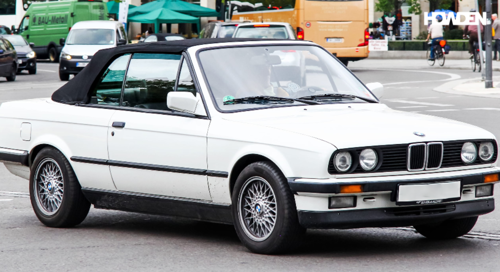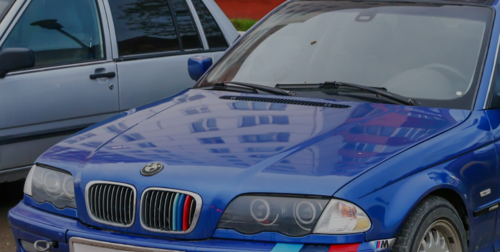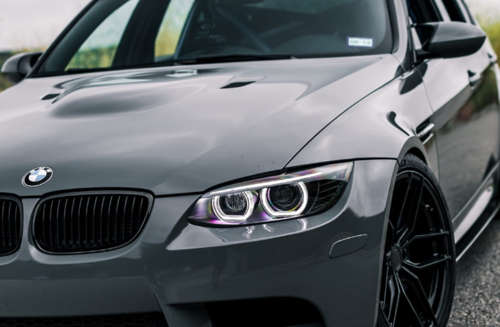27 June 2025
Celebrating 50 golden years of the BMW 3 Series
8 minutes
Alongside the movie Jaws, song Bohemian Rapsody, and of-the-moment actor Pedro Pascal, there’s one more iconic thing turning 50 in 2025 – and that’s the BMW 3 Series. And with more bite than the filmic sea monster, more might than Queen’s mini-opera, and even more fight than The Last of Us’s Joel, it’s time to look in wonder at this legendary motor series and all it represents, both then and now.
First generation: The 1975 starting point
Back in May 1975, BMW prepared themselves to launch the 3 Series at the International Motor Show in Frankfurt. This was the natural and eagerly-awaited successor to the 02 that had been on the road for around seven generations.
The first model in the 3 Series (codename E21) – was widely marketed as a ‘compact executive car’. The thinking behind it was to offer a refined driving experience, which, in a move that was several years ahead of its time (and may have been partially prompted by the fuel and oil crisis of the time, which was causing havoc for the motor industry) was also strong on safety features and better for the environment.
Initially, the maiden BMW 3 was only produced as a two-door coupe (or sedan), and ran on a four-cylinder carburetted engine. Change however was rapid, with fuel-injected models coming in later that year, and six-cylinder engines added to the mix as early as 1977. Towards the end of the first generation of the BMW 3, a cabriolet body style was introduced, which was available from 1978 to 1981.
In terms of design, main credit goes to French-born Paul Bracq who drew upon his previous experience at both Mercedes-Benz and Peugeot to create a sporty, streamlined silhouette with both slim kidney grilles and the recognisable Hofmeister kink – the rearward/forward angle near the base of the pillar at the back of the car.
On the inside, the cockpit was all about the driver experience, focusing on enhanced performance. The critical response however was that there was an element of ‘style over substance’ and that during the early E21 years, actual handling didn’t live up to the athletic exterior. The main feedback being that the Series 2 2002 model was more reactive, while the new kid on the road block felt difficult to control at the limit.
But what did all this mean for the BMW bottom line? In just six years, the E21 raced over the million sales mark. In 1980, a survey revealed 80 percent of E21 owners commented that ‘they would not change a single aspect about the vehicle’.
To end this section, we can draw upon the analogy of well-mannered, determined and highly skilled Arthur Ashe finally defeating angry, defensive and unpredictable Jimmy Connors in the 1975 Wimbledon Men’s final to describe the solid impact of the BMW 3 in these early years; from somewhat humble beginnings to the stuff of myth and legend.

Second generation: Into the 80s
It’s 1982… Italy wins the FIFA World Cup in Spain, CDs are the curious thing on the music scene, and at the end of the year, ET finally manages to ‘go home’. It’s also time for the second generation of the BMW 3. With a new serial code name, the E30 was yet another initially produced as a two-door sedan body style, with the rapid introduction of the four-door version a year later, in 1983. In another ‘first’ this was the initial 3 Series that was available as a diesel engine, and with the introduction of the 325iX model, the all-wheel drive.
The E30’s exterior aesthetic was a workable contradiction of the sporty and stripped-back practical, while the inside remained committed to the driver-focused controls of its Series 1 predecessor.
However, the improvements were all about the performance, with main credit going to a much-improved chassis and a choice of robust powertrains.
Powered by the massive revs of a S14 four-cylinder petrol engine, the higher echelons of the models were fitted with the updated six-cylinder M20 engine that were first realised in the E21.
Want to know more on the specs? The E30 323i, the M20 had a capability of 148 horsepower and 151 pound-feet of torque, while the 325i produced 168 horsepower and 164 pound-feet of torque.
Third generation: New car for the 90s
Another decade, another BMW 3 development. It’s 1990… Tim Berners-Lee has launched a very early iteration of the internet, Germany has recently reunified, and the E36 is brought into production. This limited edition M3 lightweight reflected more modern times, with its aluminium doors, adjustable splitter, smaller mirrors, and a hard-to-miss rear wing (which wasn’t attached as sold, but arrived in the boot and then had to get their dealership to install).
As a rule, the E36 was available as a sedan, coupé, convertible, wagon (given the official label of "Touring"), and that 90s favourite. There was also the hatchback – AKA the 3 Series Compact. As the name suggests, this was shorter than its boxier BMW stablemates, and was powered by four-cylinder engines.
This hatchback claimed another first for the 3 Series with the 1996 offering up six-speed manual transmission, a five-speed automatic transmission, plus a four-cylinder diesel engine (ah diesel, once so popular. Who knew?). A further upgrade of note was the multi-link rear suspension.

Fourth generation: Less girl power, more mechanical motor power
Rolling forward seven years and with Britpop dominating the charts, New Labour determined to do things differently in UK government, things (and cars) can only get better.
This series was available in sedan, coupé, convertible, wagon (marketed as "Touring"), and hatchback, more commonly known to car buyers as the 3 Series Compact. The fourth-generation E46 debuted in 1997 and was manufactured until 2006. The highly popular M3 however, was offered only as a coupe or convertible.
There was the addition of aluminium suspension parts, which some commented made for a stiffer driving experience (the chassis was estimated to be 70 per cent stiffer than the E36). But the payoff for this was improved safety, handling and performance and an upgrade to suspension, transmission, and powertrains. These changes also contributed to a nicely balanced 50/50 weight distribution – the perfect pairing for a powerful 3.2-litre inline six engine, which in the M3 CSL was capable of a mighty 360 hp.
Other impressive features for the time included satellite navigation, electronic brake-force display, ASC/DSC, rain-sensing wipers, LED tail-lights, and Xenon headlights on many models. There was also the re-introduction of the all-wheel drive, for the 325xi and 330xi sedan/wagon models. It’s also worth mentioning upgrades to transmissions, which were available as a 6-speed manual or the 6-speed "SMG-II" – the sequential manual gear box.
We’ll conclude the fourth gen story by reflecting on the aesthetics. Mainly the work of car design chief Erik Goplen, this was a neat combination of a very definite BMW design template, which somehow managed to successfully blend with modernisation, conservativism, and clean lines – clearly refining and evolving the look of the E46.
Regarded as a truly enjoyable drive, this series topped out at a whopping 3.2 million deliveries, making it the best-seller of the whole range.
Fifth generation: A new series for the millennium
While ‘Lost’ had us bewitched, befuddled, and bemused on television, one thing that hadn’t lost its way was the BMW 3. Taking us from the mid-noughties to the earlyish ‘teens,’ the E90 (or the E9X) rolled off production lines from 2005 to 2013 in the form of sedan (E90), coupe (E92), convertible (E93) and estate (E91) body styles. It was a fond farewell to the 3 Series Compact, which was replaced as the 1 Series (E87).
Never resting on the laurels of past glory, the BMW E90 featured upgrades to the powertrain, drivetrain, chassis, and safety systems. The outside of the car became more 21st Century, which aligned with a stylish and roomy interior – enabled by a lengthier wheelbase. In another modern move, this was the first generation to utilise iDrive, although the software was not without its teething problems at first.
For this generation, it’s important to call out the award-winning V8. Built as coupe, convertible and sedan variants, it remains the only mass-produced V8 across the M3 range. Talking numbers, the S65 engine galloped to 414 hp, carried 295 pound-feet of torque, with rear-wheel oomph being delivered via a six-speed manual or seven-speed dual-clutch transmission. The manual M3 was capable of 0-60 mph in 4.8 seconds, narrowly beaten by the DCT M3 in 4.6 seconds.
While legions of BMW fans had doubts about a V8-powered M3, this didn’t deter the S65 from winning the ‘International Engine of the Year’ award five times.

Sixth generation: Conquering the market
Swapping e numbers for the ‘f’ word, the sixth generation was coded as the F30 (as well as F31 and F34), and ran from 2011-2019. The buzzwords around this series were luxury, sophistication, and personalisation – as well as the expected improvements to mechanics.
Powered solely by turbocharged engines, benefitting from electric power steering, and then boosted by a plug-in hybrid drivetrain model in 2016, this latest iteration was an unashamedly bold attempt to grab customers from competitors such as Mercedes-Benz, Audi, and Lexus. This didn’t land so well with die-hard BMW drivers, some of whom felt that the brand’s USPs may have been compromised in the process. Despite this, the F30 sold more than 2.6 million, winning praise and plaudits galore from the motoring press.
The F30/F31 and F35 quickly became a part of the Series 3 firmament, coming in most shapes from a coupe to convertible, plus a newbie, the five-door hatchback "Gran Turismo" body style, with a long-wheelbase sedan proving popular in China. In fact, it accounted for 80 per cent of Series 3 sales over there.
The F30/F31/F34 coupe and convertible cars spent a year under the 3 Series umbrella before being reimagined and reclassified as part of the BMW 4 Series.
Looking closer at the specs, the B58-powered 340i had a capability of 322 hp, going from from 0 to 60 mph in 5.1 seconds. The 330e iPerformance hybrid could produce 248 hp, capable of 0 to 60 mph time of 6.1 seconds. All this and still an emphasis on sustainability and greener engineering.
Ultimately, in terms of legacy, the F30 remains a bit of a head-scratcher. The combination of luxe features and comfort, increased software, and reliable features means many remain unsure whether this recent iteration was a stylish rule-breaker or just a little bit safe. But with 2.6 million sales, it certainly got something right.
Seventh generation: Right here, right now
Driving a path to the G-spot, from 2019 onwards is the G20. Making its debut appearance at the 2018 Paris Motor Show, and presenting an altogether more dynamic vision than its F30 predecessor, this seventh gen series reflects a desire to get back to the core of BMW’s dynamic DNA, getting the joy back into driving. Revisions and upgrades have been made not just to the chassis, but also to steering, suspension, and the powertrain.
Using the CLAR (Cluster Architecture) platform, the G20 makes the most of high-strength steel and aluminium, while building in a MacPherson strut front suspension, multi-link rear suspension, and hydraulic damping system – ideal for absorbing impacts.[15]
The G20 is also 55 kg (121 lb) lighter, 85 mm (3.3 in) longer, and 16 mm (0.6 in) wider than previous models. And while maintaining that 50:50 weight distribution, there’s now a 50 per cent increase in body rigidity.
Other developments include an electronic parking brake and engine coasting modes, while in a continued nod to environmental awareness, most models now incorporate engine particulate filters.[24]
Many types come as four-wheel drives, and when purchasing one of these, you can expect full LED headlights and tail-lights, automatic climate control, plus driver assistance systems as standard.
Revving up the tech specs, there’s iDrive 8.5, Apple CarPlay/Android Auto, and intelligent personal assistant.

50 years of bold and gold
There it is – half a century of the BMW 3, and still going strong. It’s a series that may have taken a couple of detours, but always remained on track – keeping the focus on brand truths, trusted engineering, and innovation, as well as making driving a pleasure, of course.
And the further good news is that many of the 3 Series are covetable classics. So, if you’re in the market for investment or want to ensure your current car is comprehensively insured, speak to the Classic Motor team today on 01252 377 546 or email classicmt@howdeninsurance.co.uk.
